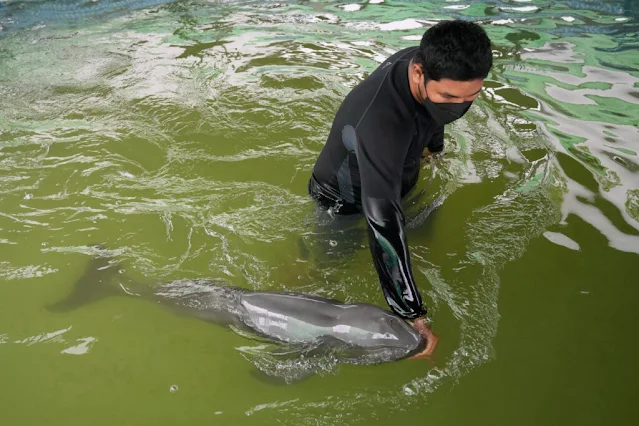The ill Irrawaddy dolphin calf was dying in a tidal lagoon off the coast of
Thailand when fisherman came upon him.
As soon as the fisherman made the contact, marine conservationists offered
them guidance on how to care for the child until a rescue crew could
come.
Because everyone concerned knew it would be difficult to preserve the
dolphin's life, the baby was given the name Paradon, which translates to
"brotherly burden."
Three rivers in Myanmar, Cambodia, and Indonesia as well as the shallow
coastal seas of South and Southeast Asia are home to Irrawaddy
dolphins.
The International Union for Conservation of Nature has designated dolphins
as an endangered species due to habitat loss, pollution, and fishing methods
that unintentionally catch dolphins with other species.
Officials at the marine research agency estimate that 400 Irrawaddy
dolphins still reside along Thailand's eastern coast, which borders
Cambodia.
Since the fisherman found Paradon on July 22, several veterinarians and
volunteers have helped care for him at the facility in Rayong on the Gulf of
Thailand.
Thanaphan Chomchuen, a veterinarian at the facility, stated, "We thought
among ourselves that the possibility of his surviving was pretty poor,
judging from his condition."
He was treated for his lung infection, placed in a saltwater pool, and
volunteers were enlisted to continually monitor him.
They have to hold him up in his tank and feed him milk at first through a
feeding tube, then a bottle once he has built some muscle, to prevent him
from drowning.
A staff veterinarian, one or two volunteers, and other workers who are in
charge of the water pump and filter and are in charge of making milk for the
calf throughout the day are all included in each eight-hour shift.
Paradon is improving after a month. The calf, estimated to be between four
and six months old, can now swim and exhibits no symptoms of sickness.
The dolphin, who was roughly 27 kilograms (59 pounds) and 138 centimeters
long (4.5 feet) on July 22, is still feeble and doesn't swallow enough milk
despite the team's best efforts to feed him every 20 to 30 minutes or
so.
Thippunyar Thipjuntar, a 32-year-old financial expert, is one of the many
volunteers that come up for a babysitting assignment with Paradon.
Thippunya stated she was drawn to Paradon and worried about his development
because of his round infant face and curled lips that resembled a
smile.
He doesn't eat enough and prefers to play more than anything else. As she
fed the sleeping Paradon on Friday, she told The Associated Press, "I am
concerned that he does not get enough nutrients.
"Of course you desire that kid will grow strong and survive when you commit
your time, effort, money, and mental focus to come here as a
volunteer."
According to Sumana Kajonwattanakul, director of the marine center, Paradon
will need long-term care, maybe for up to a year, until he is weaned from
milk and capable of foraging for his own food.
"The issue is that he won't be able to get milk if we just release him when
he gets healthier."
"We'll have to look after him until he gets teeth, and then we'll have to
teach him how to eat fish and how to live in a pod. It will take some time,"
Sumana predicted.
The individuals who take care of Paradon believe the extensive, attentive,
and loving care is worthy.
The veterinarian Thanaphan added, "There haven't been many successful
examples in treating this sort of animal, so if we can rescue one dolphin,
it will improve our expertise."
"We will have learnt so much from this if we can save him and he
lives."
Second, I believe that by saving him and providing him a chance to survive,
we also spread knowledge about the need to preserve this endangered type of
animal.
Tags:
animals





